You’ll need seven essential jewelry pliers to master professional-quality work: round nose pliers for creating perfect loops and curves, flat nose pliers for gripping and angular bends, chain nose pliers for tight spaces and jump rings, bent nose pliers for hard-to-reach areas, crimping pliers for secure connections, nylon jaw pliers to prevent scratching, and side cutters for clean wire trimming. Each tool serves specific functions that’ll elevate your crafting precision and expand your creative possibilities.
Round Nose Pliers
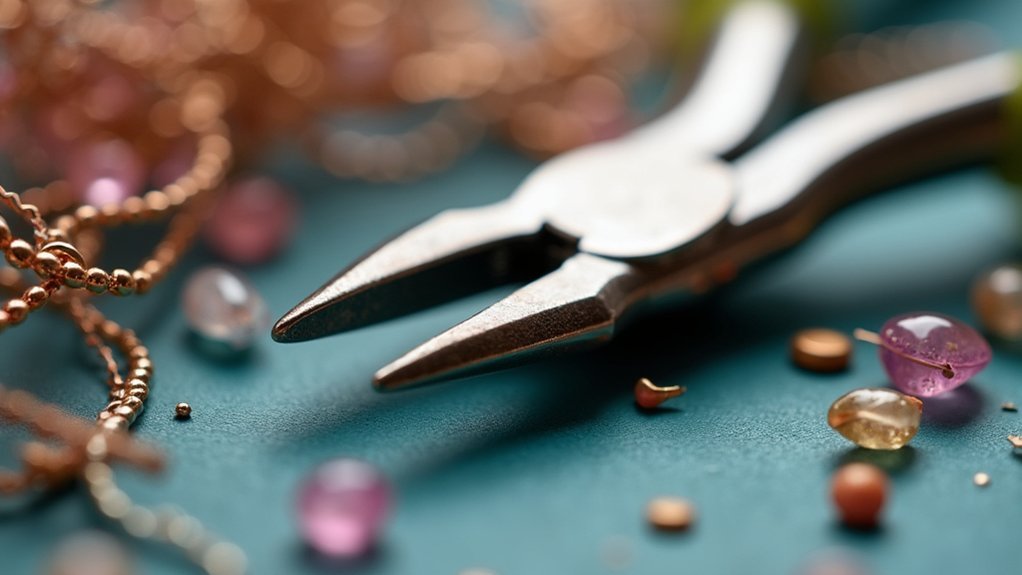
Round nose pliers stand as the cornerstone tool for any jewelry maker’s toolkit, featuring distinctive tapered conical jaws that excel at forming precise loops and graceful curves in wire.
These jewelry making pliers enable you to create consistent loops essential for jump rings and wire wrapping projects. Their pointed tips shine when accessing tight spaces, allowing intricate work without damaging surrounding materials.
Round nose pliers provide the precision and access needed for professional loop formation in tight jewelry-making spaces.
When forming loops, you’ll want to apply even pressure to prevent denting or marring your wire, ensuring a professional finish.
Beyond loop creation, these versatile tools excel at bending wire at various angles, giving you enhanced design flexibility.
For jewelry makers seeking precision and control, round nose pliers deliver the reliability needed for both basic and complex wirework techniques.
Flat Nose Pliers
While round nose pliers excel at curves and loops, flat nose pliers serve as the precision workhorses for angular work and secure gripping tasks in jewelry making. These versatile tools feature rectangular cross-sections with perfectly flat jaws, making them essential for bending angles in wire and sheet metal with precision.
| Task | Application | Benefit |
|---|---|---|
| Bending | Wire shaping | Sharp angles |
| Gripping | Holding small beads | Secure control |
| Jump rings | Opening and closing jump rings | Damage prevention |
| Filing | Bezel wire work | Stable positioning |
| Sheet metal | Flat surface handling | Even pressure |
Their ergonomic design guarantees comfortable handling during extended sessions, reducing hand fatigue. Jewelry makers rely on flat nose pliers for detailed work requiring steady grip and precise control.
Chain Nose Pliers
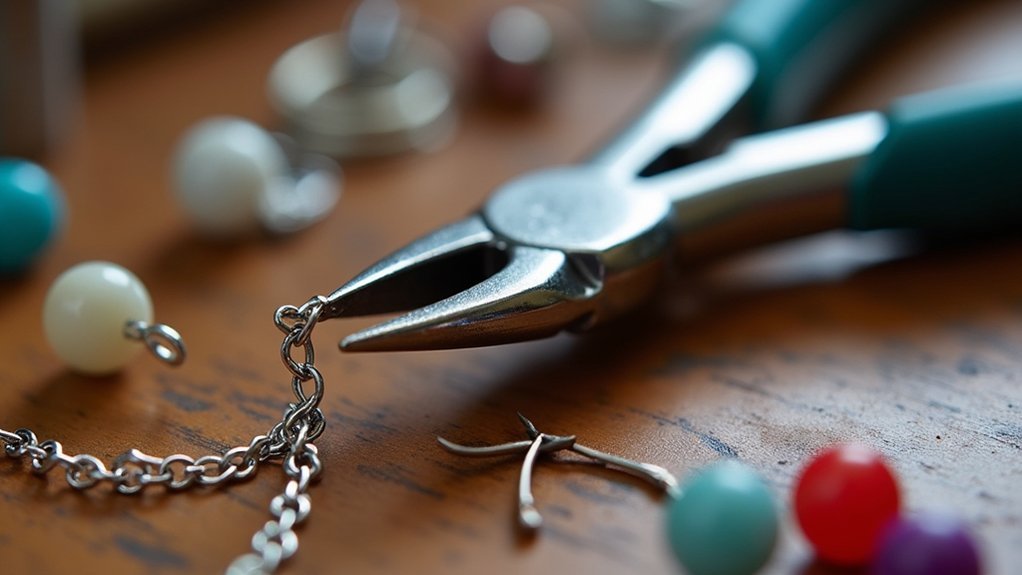
Chain nose pliers bridge the gap between the broad, flat surfaces of flat nose pliers and the curved functionality of round nose tools.
You’ll find their flat jaws with rounded outer edges perfect for gripping small components without marring delicate metals. Their tapered design gives you access to tight spaces, making them essential for intricate jewelry-making tasks.
You can use chain nose pliers for bending wire with precision and creating smooth loops or curves. They’re particularly effective for opening and closing jump rings, providing the secure grip you need.
When shaping wire, you’ll appreciate their utility in conjunction with other pliers. Their versatility makes them indispensable whether you’re a beginner learning basic techniques or an experienced artisan tackling complex projects.
Bent Nose Pliers
Because bent nose pliers feature jaws angled at 45 degrees, they excel at reaching confined spaces that straight-nosed tools simply can’t access.
You’ll find these essential tools perfect for intricate jewelry projects where precision matters most. Their tapered tips enable precise manipulation of small components while maintaining clear sight lines to your work area.
You can use them for wire wrapping, tucking sharp edges, and holding components securely without interference. When you’re shaping and bending wire, bent nose pliers offer superior control compared to straight alternatives.
Jewelry makers rely on these versatile tools for detailed, repetitive tasks.
You’ll want ergonomic handles for comfort during extended use, as the angled design naturally positions your hand for ideal leverage and reduced fatigue.
Crimping Pliers
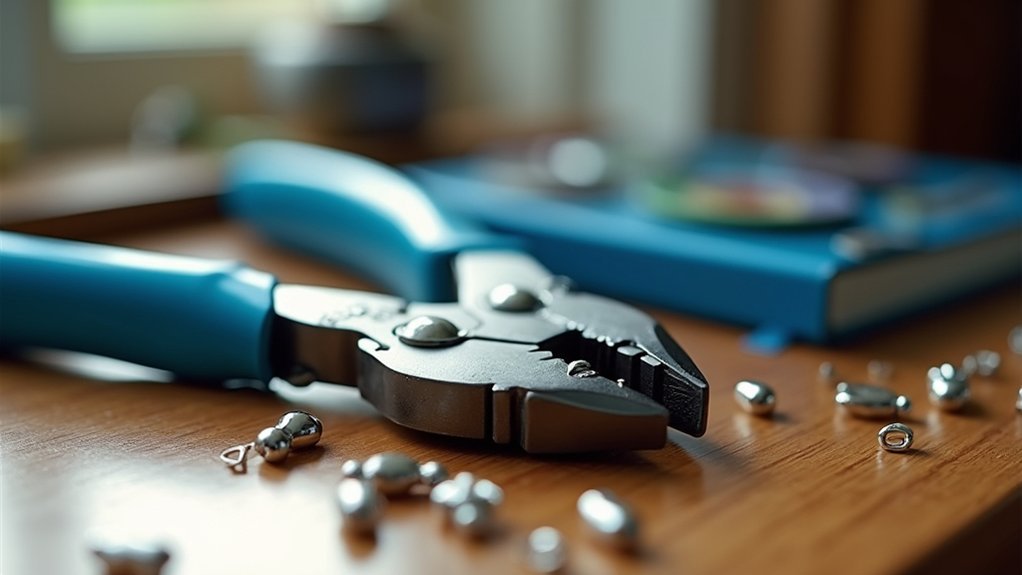
Precision becomes paramount when securing crimp beads and tubes to beading wire, making crimping pliers an indispensable tool for professional-quality jewelry construction.
These specialized tools feature notched jaws that create smooth, rounded crimps while preventing sharp edges that could damage your wire or thread.
You’ll achieve consistent, even pressure with crimping pliers, resulting in a professional finish that enhances your jewelry’s durability. Unlike standard pliers, these tools secure crimp beads effectively through their specialized design.
Key advantages of crimping pliers include:
- Multiple stations accommodate different crimp sizes for various beading projects
- Specialized notched jaws create smooth, professional crimps
- Consistent pressure application guarantees reliable connections
- Enhanced versatility across different jewelry making techniques
- Superior security compared to using fingers or basic pliers
Nylon Jaw Pliers
While crimping pliers excel at securing connections, nylon jaw pliers protect your delicate metals and findings from surface damage during manipulation.
You’ll find these specialized tools invaluable when holding and shaping jewelry components that scratch easily. The nylon tips provide a secure grip while maintaining your work’s pristine finish.
Nylon jaw pliers deliver the perfect grip for delicate jewelry work without leaving scratches or marks on precious metals.
You can straighten kinks in soft metals without worrying about marks or damage. When you’re working with expensive materials like sterling silver or gold-filled wire, nylon jaw pliers prevent scratching that could compromise your piece’s professional appearance.
They’re an essential tool for any serious jeweler.
Remember that nylon tips wear out over time and require replacement to maintain ideal protection for your components.
Side Cutters
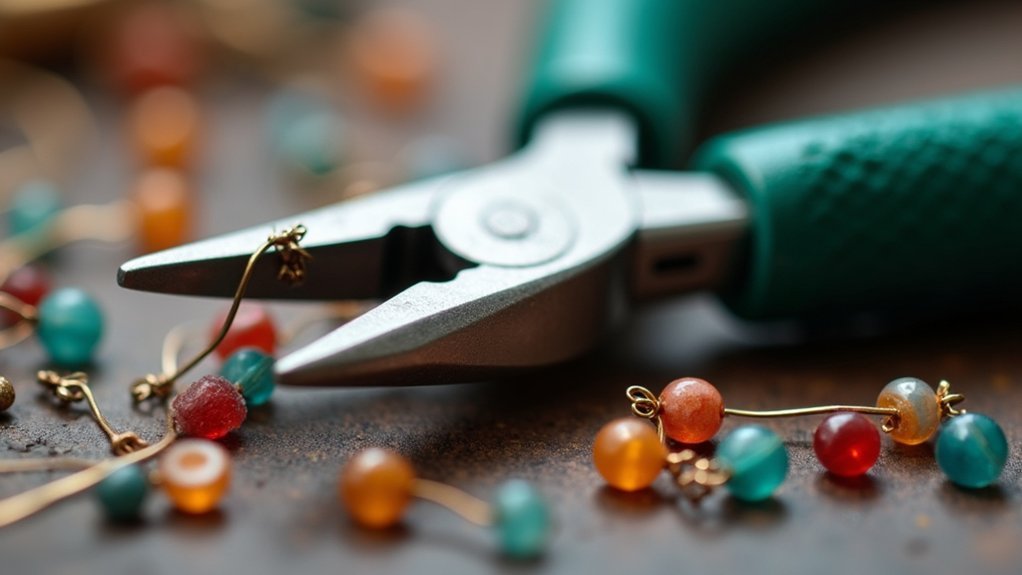
You’ll find side cutters essential for cleanly trimming wire ends and cutting through various jewelry materials with precision.
Their angled cutting edges let you make flush cuts that won’t leave sharp or jagged wire ends on your finished pieces.
When selecting side cutters, you’ll want to invest in quality tools with sharp, durable blades that maintain their cutting edge through repeated use.
Wire Cutting Capabilities
Side cutters stand out as the most essential cutting tool in any jewelry maker’s arsenal, specifically engineered to slice through thin metal wire and flexible jewelry string with surgical precision.
Their angled cutting edges enable superior access to tight spaces while delivering clean, professional results without damaging surrounding materials.
Understanding your side cutters’ capabilities maximizes your jewelry making potential:
- Diagonal vs. flush cutters – Choose diagonal for general cutting wire tasks or flush cutters for super-smooth finishes
- Angle cutting advantages – Angled edges reach confined areas other tools can’t access
- Precision cuts every time – Sharp edges maintain accuracy even after extensive use
- Durable steel construction – Quality materials guarantee long-lasting performance through countless projects
- Enhanced control techniques – Gripping near the hinge improves precision and prevents wire end damage
Choosing Quality Cutters
Investing in premium side cutters transforms your jewelry making experience from frustrating struggles with inferior tools to effortless, professional-grade results.
When selecting side cutters for cutting wire, prioritize durable steel construction that guarantees longevity and consistent performance throughout demanding jewelry making projects.
Consider jaw size carefully to match your specific wire thicknesses. Smaller jaws provide enhanced precision for delicate work, while larger jaws handle thicker materials effectively. Choose between flush and super flush cutting edges based on your finishing requirements.
Quality side cutters deliver effective cutting performance that justifies the investment. Regular maintenance, including cleaning debris and applying light lubrication, preserves cutting sharpness and prevents premature wear.
High-grade steel maintains its edge longer, reducing replacement frequency and guaranteeing clean cuts every time.
Frequently Asked Questions
What Are the Different Types of Jewelry Pliers?
You’ll find five main types: round nose pliers for forming loops, flat nose for bending angles, chain nose for precise gripping, bent nose for tight spaces, and crimping pliers for attaching crimp beads.
What Is the Purpose of Each Type of Pliers?
You’ll use round nose pliers for forming loops, flat nose for bending angles, chain nose for precise grips, bent nose for tight spaces, and crimping pliers for securing crimp beads professionally.
What Are Pliers Used for in Jewelry Making?
You’ll use pliers for bending and shaping wire, creating loops, manipulating metal components, opening jump rings, holding pieces steady, and cutting materials. They’re essential for precise control and professional-quality results in your jewelry projects.
What Is the Difference Between Flat Nose and Chain Nose Pliers?
You’ll find flat nose pliers have completely flat, wide jaws perfect for gripping larger surfaces and making sharp bends, while chain nose pliers feature tapered jaws ideal for precision work in tight spaces.
In Summary
You’ve now got the essential knowledge about seven fundamental jewelry pliers and their specific uses. Whether you’re creating delicate wire wraps with round nose pliers or making precise cuts with side cutters, each tool serves a unique purpose in your jewelry-making toolkit. Don’t try to substitute one plier for another’s job—you’ll get better results when you use the right tool for each technique you’re attempting.



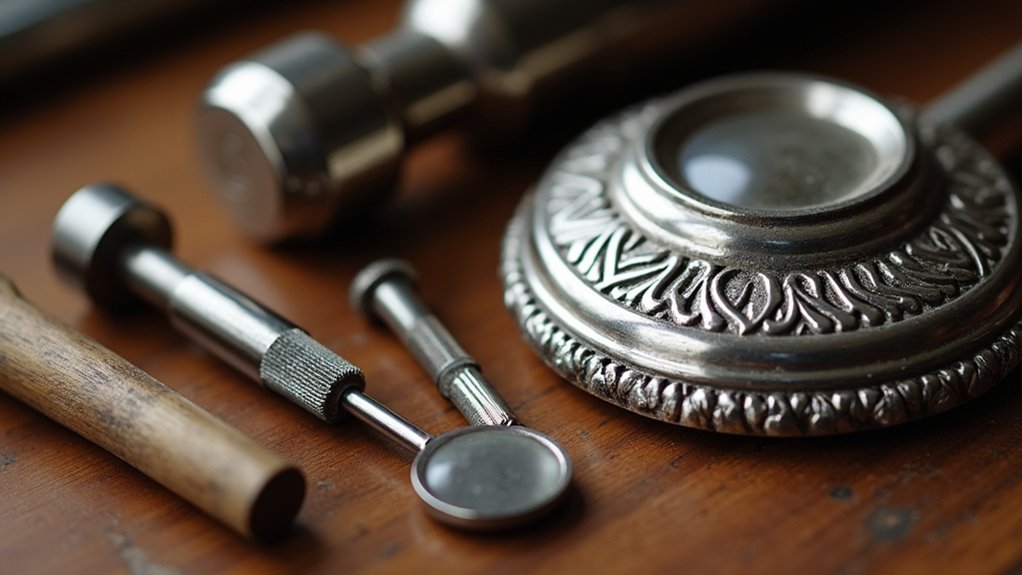

Leave a Reply